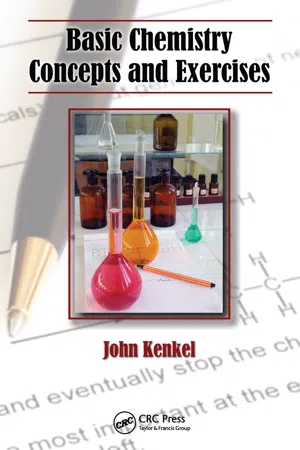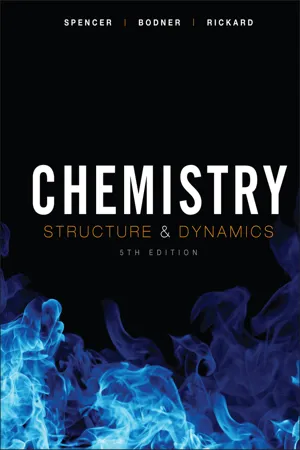Physics
Atomic Model
The atomic model is a scientific theory that describes the structure of an atom. It proposes that atoms consist of a nucleus containing protons and neutrons, surrounded by electrons in specific energy levels or shells. This model helps to explain the behavior and properties of elements and is fundamental to understanding the nature of matter.
Written by Perlego with AI-assistance
Related key terms
1 of 5
5 Key excerpts on "Atomic Model"
- eBook - PDF
- Morris Hein, Susan Arena, Cary Willard(Authors)
- 2016(Publication Date)
- Wiley(Publisher)
In chemistry we use models (theories) such as Dalton’s Atomic Model to explain the behavior of atoms, molecules, and compounds. Models are modified to explain new infor- mation. We frequently learn the most about a system when our models (theories) fail. That is the time when we must rethink our explanation and determine whether we need to modify our model or propose a new or different model to explain the behavior. 5.1 Dalton’s Model of the Atom Describe Dalton’s model of the atom and compare it to the earlier concepts of matter. The structure of matter has long intrigued and engaged us. The earliest models of the atom were developed by the ancient Greek philosophers. About 440 B.C. Empedocles stated that all matter was composed of four “elements”—earth, air, water, and fire. Dem- ocritus (about 470–370 B.C.) thought that all forms of matter were composed of tiny indivisible particles, which he called atoms, derived from the Greek word atomos, meaning “indivisible.” He held that atoms were in constant motion and that they combined with one another in various ways. This hypothesis was not based on scientific observations. Shortly thereafter, Aristotle (384–322 B.C.) opposed the theory of Democritus and instead endorsed and advanced the Empedoclean theory. So strong was the influence of Aristotle that his theory dominated the thinking of scientists and philosophers until the beginning of the seventeenth century. More than 2000 years after Democritus, the English schoolmaster John Dalton (1766–1844) revived the concept of atoms and proposed an Atomic Model based on facts and experimental evidence (FIGURE 5.1). His theory, described in a series of papers pub- lished from 1803 to 1810, rested on the idea of a different kind of atom for each element. The essence of Dalton’s Atomic Model may be summed up as follows: 1. Elements are composed of minute, indivisible particles called atoms. 2. Atoms of the same element are alike in mass and size. - eBook - PDF
- John Kenkel(Author)
- 2010(Publication Date)
- CRC Press(Publisher)
Thus the nuclear model was born . In this model, the space outside and between the nuclei is viewed as being mostly empty space and is occupied by the electrons, the extremely small and light particles of negative charge . Figure 4 .3 shows how there could be different paths taken by the alpha particles as they encountered, or did not encounter, the gold nuclei . In order to explain some cathode ray phenomena observed 25 years ear-lier by other scientists, Rutherford proposed in 1914 that smaller positively charged particles were contained within the nucleus . He named these particles protons . Neutrons in the nucleus were proposed by the British scientist James Chadwick in 1932 as a result of additional experiments . * Two other models for the atom are important . One was proposed by a Danish scientist by the name of Neils Bohr in 1913 . † This model was called the solar system model because he proposed that the electrons orbit the nucleus much like the planets orbit the sun . The other was proposed by Austrian physicist Erwin Schrodinger in 1926 . ‡ The Schrodinger model is called the quantum mechanical model and is the model that we use today to explain and predict atomic behavior . Each of these two models is explained more fully in the sections that follow . A summary of the history of the development of atomic theory is given in Table 4 .1 4.3 Modern Theory of Light To have a clear understanding of the atomic theories espoused by Bohr and Schrodinger, and therefore a clear understanding of the current models of atomic structure, we must first briefly explore the modern theory of the nature of light, which is a form of energy . * James Chadwick won the Nobel Prize in physics in 1935 for his discovery of the neutron . † Neils Bohr won the Nobel Prize in physics in 1922 for his solar system model . ‡ Schrodinger won the Nobel prize in 1933 for his model . - eBook - PDF
Chemistry
Structure and Dynamics
- James N. Spencer, George M. Bodner, Lyman H. Rickard(Authors)
- 2011(Publication Date)
- Wiley(Publisher)
71 Chapter Three THE STRUCTURE OF THE ATOM 3.1 Rutherford’s Model of the Atom 3.2 Particles and Waves 3.3 Light and Other Forms of Electromagnetic Radiation 3.4 Atomic Spectra 3.5 The Wave-Packet Model of Electromagnetic Radiation 3.6 The Bohr Model of the Atom 3.7 The Energy States of the Hydrogen Atom 3.8 Electromagnetic Radiation and Color 3.9 The First Ionization Energy 3.10 The Shell Model 3.11 The Shell Model and the Periodic Table 3.12 Photoelectron Spectroscopy and the Structure of Atoms 3.13 Electron Configurations from Photoelectron Spectroscopy 3.14 Allowed Combinations of Quantum Numbers 3.15 Shells and Subshells of Orbitals 3.16 Orbitals and the Pauli Exclusion Principle 3.17 Predicting Electron Configurations 3.18 Electron Configurations and the Periodic Table 3.19 Electron Configurations and Hund’s Rules 3.20 The Sizes of Atoms: Metallic Radii 3.21 The Sizes of Atoms: Covalent Radii 3.22 The Relative Sizes of Atoms and Their Ions 3.23 Patterns in Ionic Radii 3.24 Second, Third, Fourth, and Higher Ionization Energies 3.25 Average Valence Electron Energy (AVEE) 3.26 AVEE and Metallicity 3.1 Rutherford’s Model of the Atom Shortly after radioactivity was discovered at the turn of the twentieth century, Ernest Rutherford became interested in the alpha particles, or ions emitted by uranium metal and its compounds. Rutherford found that particles were absorbed by a thin sheet of metal, but they could pass through metal foil if it was thin enough. Rutherford noticed that a narrow beam of particles was broadened as it passed through the metal foil. Working with his assistant Hans Geiger, Ruther- ford measured the angle through which the particles were scattered by a thin piece of gold foil. Because it is unusually ductile, gold can be made into a foil that is only 0.00004 cm––or about 2000 atoms––thick. When the foil was bom- barded with particles, Rutherford and Geiger found that the angle of scattering was small, on the order of 1. - eBook - PDF
Introductory Chemistry
An Active Learning Approach
- Mark Cracolice, Edward Peters, Mark Cracolice(Authors)
- 2020(Publication Date)
- Cengage Learning EMEA(Publisher)
Editorial review has deemed that any suppressed content does not materially affect the overall learning experience. Cengage Learning reserves the right to remove additional content at any time if subsequent rights restrictions require it. 156 Chapter 5 Atomic Theory: The Nuclear Model of the Atom Dalton realized that the three laws could be explained if matter was made of atoms. Dalton’s atomic theory accounts for chemical reactions in this way: Before the reaction, the reacting substances contain a certain number of atoms of different elements. As the reaction proceeds, the atoms are rearranged to form the products. The atoms are neither created nor destroyed but are simply arranged differently. The starting arrangement is destroyed (reacting substances are destroyed in a chemical change), and a new arrangement is formed (new substances form). The main features of Dalton’s atomic theory are as follows (Figure 5.4): a summary of… Dalton’s Atomic Theory 1. Each element is made up of tiny, individual particles called atoms. 2. Atoms are indivisible; they cannot be created or destroyed. 3. All atoms of any one element are identical in every respect. 4. Atoms of one element are different from atoms of any other element. 5. Atoms of one element combine with atoms of other elements to form chemical compounds. As with many new ideas, Dalton’s theory was not immediately accepted. However, over time, an overwhelming quantity of evidence has accumulated to erase any doubt about the existence of atoms. Relatively recently, in 2013, scientists were able to capture the first images of atomic theory in action. Figure 5.5 shows a molecule with 26 carbon atoms and 14 hydrogen atoms undergoing a chemical change to become a different molecule composed of the same atoms. Figure 5.4 Atoms according to Dalton’s atomic theory. - eBook - PDF
- Richard L. Myers(Author)
- 2005(Publication Date)
- Greenwood(Publisher)
A Modern View of the Atom Introduction By 1935, it was believed the internal structure of the atom had been determined. The proton, electron, and neutron had been discovered, and although these were considered fundamental particles, still more particles were being theo- rized and discovered. In 1930 Wolfgang Pauli proposed a particle to account for the viola- tion of conservation of energy and momentum during beta decay. Pauli's ghost particle was dubbed the neutrino (little neutron) by Enrico Fermi (1901-1954). In 1932 Carl David Anderson (1905-1991) discovered two sub- atomic particles while studying cosmic rays. These were the positron (a positively charged electron) and muon. Positrons are a form of antimatter. Antimatter consists of particles that have the same mass as ordinary matter, but differ in charge or some other property. Antineutrons have different magnetic prop- erties compared to regular neutrons. By the 1960s, several hundred different subatomic particles had been identified, and the ques- tion of what was a fundamental particle was open to debate. This led to the development of the standard model of fundamental particles and interactions, generally referred to as the standard model. This chapter will focus on the standard model and discusses the fundamental particles given by this model. Particle Detectors and Accelerators To observe subatomic particles that are very small and can travel at speeds approaching the speed of light requires spe- cial instruments. Particle detectors are used for observing at the subatomic level and pro- vide indirect visible evidence of particles. Several different types of detectors exist that operate by recording the tracks made by particles that interact with them. A detector can be compared to examining tracks made on a muddy road. A person would be able to distinguish whether a person, bicycle, or vehicle passed along the road.
Index pages curate the most relevant extracts from our library of academic textbooks. They’ve been created using an in-house natural language model (NLM), each adding context and meaning to key research topics.




